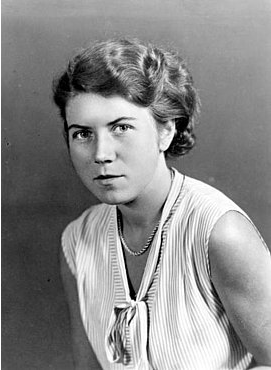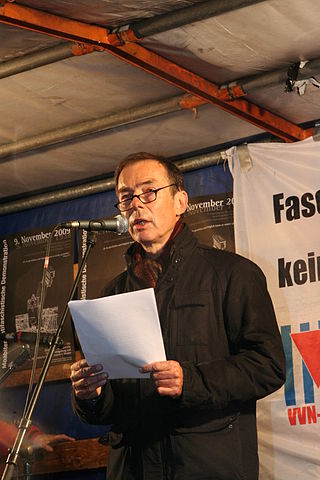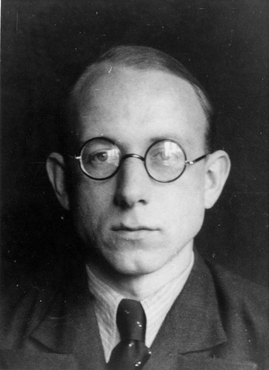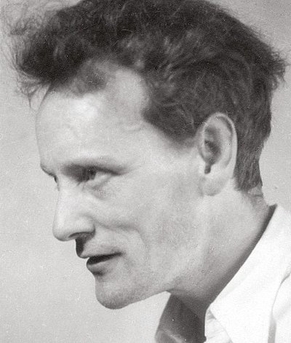
The Red Orchestra was the name given by the Abwehr Section III.F to anti-Nazi resistance workers in Germany in August 1941. It primarily referred to a loose network of resistance groups, connected through personal contacts, uniting hundreds of opponents of the Nazi regime. These included groups of friends who held discussions that were centred on Harro Schulze-Boysen, Adam Kuckhoff and Arvid Harnack in Berlin, alongside many others. They printed and distributed prohibited leaflets, posters, and stickers, hoping to incite civil disobedience. They aided Jews and resistance to escape the regime, documented the atrocities of the Nazis, and transmitted military intelligence to the Allies. Contrary to legend, the Red Orchestra was neither directed by Soviet communists nor under a single leadership. It was a network of groups and individuals, often operating independently. To date, about 400 members are known by name.

Wilhelm Guddorf was a Belgian journalist, anti-Nazi and resistance fighter against the Third Reich. Guddorf was a leading member of a Berlin anti-fascist resistance group that was later called the Red Orchestra by the Abwehr. Guddorf was the editor of the Communist Die Rote Fahne newspaper.

Hans-Wedigo Robert Coppi was a German resistance fighter against the Nazis. He was a member of a Berlin-based anti-fascist resistance group that was later called the Red Orchestra by the Gestapo.

Mildred Elizabeth Harnack was an American literary historian, translator, and member of the German resistance against the Nazi regime. After marrying Arvid Harnack, she moved to Germany in 1929, where she began her career as an academic. Mildred Harnack spent a year at the University of Jena and the University of Giessen working on her doctoral thesis. At Giessen, she witnessed the beginnings of Nazism. Mildred Harnack became an assistant lecturer in English and American literature at the University of Berlin in 1931.

Heinz Harro Max Wilhelm Georg Schulze-Boysen was a left-wing German publicist and Luftwaffe officer during World War II. As a young man, Schulze-Boysen grew up in prosperous family with two siblings, with an extended family who were aristocrats. After spending his early schooling at the Heinrich-von-Kleist Gymnasium and his summers in Sweden, he part completed a political science course at the University of Freiburg, before moving to Berlin in November 1929, to study law at the Humboldt University of Berlin. At Humboldt he became an anti-Nazi. After a visit to France in 1931, he moved to the political left. When he returned, he became a publicist on Der Gegner, a left-leaning political magazine. In May 1932, he took control of the magazine, but it was closed by the Gestapo in February 1933.

Elisabeth Schumacher was a German artist, photographer, and resistance fighter against the Nazi regime. She was a member of the Berlin-based anti-fascist resistance group that was later called the Red Orchestra by the Abwehr, during the Third Reich. Schumacher trained as an artist, but as her father was Jewish, she was classified as half-Jewish or Mischling, so worked as a graphic artist, before joining the resistance efforts.

Maria "Mimi" Terwiel was a German resistance fighter against the Nazi regime. She was active in a group in Berlin that wrote and distributed anti-Nazi and anti-war appeals. As part of what they conceived as a broader action against a collection of anti-fascist resistance groups in Germany and occupied Europe that the Abwehr called the Red Orchestra, in September 1942 the Gestapo arrested Terwiel along with her fiancée Helmut Himpel. Among the leaflets and pamphlets they had copied and distributed for the group were the July and August 1941 sermons of Clemens August Graf von Galen which denounced the regime's Aktion T4 programme of involuntary euthanasia.

Kurt Schumacher was a German sculptor and Communist member of the German Resistance fighter who was a member of the anti-fascist resistance group that was later called the Red Orchestra by the Gestapo. He was married to the painter and graphic designer, Elisabeth Schumacher who was also an anti-fascist.

Hans Coppi Jr. is a German historian. His parents, Hilde and Hans Coppi, were active in the German Resistance and were both executed by the Nazis.

Horst Heilmann was a German resistance fighter against the Nazi regime. He was a member of the anti-fascist resistance group that formed around Harro Schulze-Boysen in 1940. Later, the people of the group along with many others were bundled together and called the Red Orchestra by the Abwehr. Heilmann was a student and a wireless operator who worked at the Referat 12 that was in the Inspectorate 7/VI.

Walter Küchenmeister was a German machine technician, journalist, editor, writer and resistance fighter against the Nazi regime. Küchenmeister was a member of the anti-fascist resistance group, that was later called the Red Orchestra by the Abwehr. Küchenmeister was notable for being part of the close group that constituted the Schulze-Boysen group of individuals.

Oda Schottmüller was an expressive dancer, mask maker and sculptor. Schottmüller was most notable as a resistance fighter against the Nazis, through her association with a Berlin-based anti-fascist resistance group that she met through the sculptor Kurt Schumacher. The group would later be named by the Gestapo as Die Rote Kapelle.
Gisela von Pöllnitz was a German journalist, communist, and resistance fighter against the Nazi regime. During the Nazi regime, she was a notable member of the Berlin-based anti-fascist resistance group around Harro Schulze-Boysen, later called the Red Orchestra by the Abwehr. Throughout her life von Pöllnitz had a lung condition that progressively worsened after being arrested several times by the Gestapo. On her final arrest by the Gestapo she contracted tuberculosis after 5 months in custody. Her physician Elfriede Paul arranged a sanitarium in Switzerland, but she never recovered.
Elly Lotte Bergtel-Schleif, née Schleif, was a German librarian who was actively involved in the resistance against Nazis while a member of the Communist Party of Germany (KPD). Bergtel-Schleif became head of the Berlin Library School after the war.

Karl Behrens He was a design engineer and resistance fighter against Nazism. Behrens was most notable for being a member of the Berlin-based anti-fascist resistance group, that was later called the Red Orchestra by the Abwehr. Behrens acted as a courier for the group, passing reports between Arvid Harnack and Hans Coppi who was the radioman. Behrens was also active in a resistance group at the AEG turbine factory power together with Walter Homann and others.
Friedrich Rehmer was a German factory worker and resistance fighter against the Nazi regime. While attending an evening school in Schöneberg, Rehmer met a group of friends that included Ursula Goetze, Otto Gollnow, Hannelore Thiel, Liane Berkowitz, John Rittmeister and Werner Krauss. In December 1941, he became part of an anti-fascist network after meeting Harro Schulze-Boysen through Wolfgang Rittmeister, brother to John Rittmeister. The network was later called the Red Orchestra by the Abwehr. Rehmer was executed in 1943.

Fritz Thiel was a German precision engineer and resistance fighter against the Nazi regime. He became part of a Berlin-based anti-fascist resistance group during World War II, that was later named the Red Orchestra by the Abwehr. Thiel along with his wife Hannelore were most notable for printing stickers using a child's toy rubber stamp kit, that they used to protest The Soviet Paradise exhibition in May 1942 in Berlin, that was held by the German regime to justify the war with the Soviet Union. The group found the exhibition both egregious and horrific; one exhibited photograph showed a young woman and her children hanged side by side. Thiel was executed for his resistance action.

Walter Husemann was a German communist and resistance fighter against the Nazi regime. As a young man, Husemann trained an industrial toolmaker, before training as a journalist. He became interested in politics and joined the Communist Party of Germany (KPD). With the arrival of the Nazis in 1933, he became a resistance fighter and through his wife, the actor Marta Husemann, he became associated with an anti-fascist resistance group around Harro Schulze-Boysen and Arvid Harnack that was later called the Red Orchestra by the Gestapo. Along with John Sieg whom he met in the KPD and Fritz Lange, Martin Weise and Herbert Grasse he wrote and published the resistance magazine, The Internal Front Die Innere Front.

Wilhelm "Willy" Schürmann-Horster was a German actor, dramaturge, and director, who was a marxist and dedicated communist, and who became a resistance fighter against the Nazis. As a young man, Schürmann-Horster trained as an actor at the Düsseldorf Drama School. During the 1920s he worked in various acting troupes in theatres in the Rhineland. By the mid 1930s, he had become a communist and in 1934 and 1935 he was arrested for political agitation but acquitted for lack of evidence. After moving to Berlin in 1937, he met and became friends with Cay and Erika von Brockdorff. Through them, a discussion group of like-minded friends was formed who openly discussed current affairs and Schürmann-Horster became their spokesman. Through contacts in the group, connections were made with a resistance organisations that was run by Harro Schulze-Boysen and Arvid Harnack in 1940. Although Schürmann-Horster wasn't a physical resistance fighter in the cast of Harro Schulze-Boysen, he was an intellectual opponent of the Nazis who displayed his convictions on the stage and as a result never took part in any of the operations that his friends undertook. After falling ill in 1941, Schürmann-Horster moved to Konstanz where he worked as a dramaturge at the Grenzland Theatre. In October 1942, he was arrested and sentenced to death for "high treason", "dissemination of illegal writings" and "aiding and abetting the enemy" by the 2nd senate of the Volksgerichtshof. He was executed in Plötzensee Prison on 9 September 1943. He was described by his close friend, the communist trade unionist Rudy Goguel in the daily newspaper Südkurier as

Eva Rittmeister was a German paediatric nurse, later office worker who became a resistance fighter against the Nazis. During World War II, Rittmeister became involved a Berlin-based resistance group that later became known as the Red Orchestra.



















